Lessico
Cetriolo
Cucumis sativus
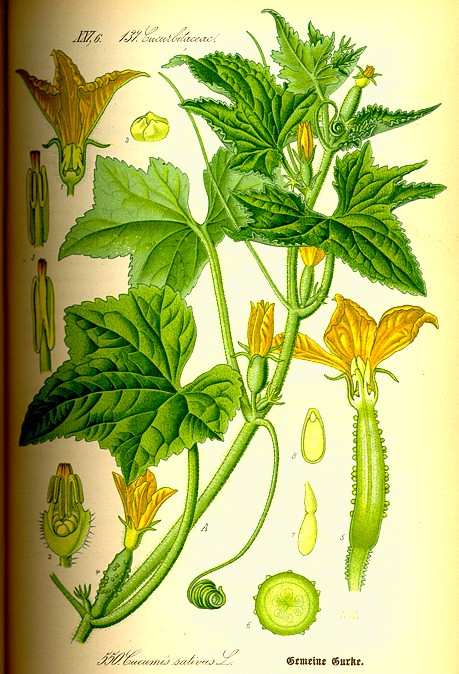
Nel latino
parlato il cetriolo suonava *citriolum, diminutivo del classico citrium
= cetriolo, da citrus, il cedro, Citrus medica o Pomo della
Media![]() . Venne
chiamato citrium per il colore giallo (il tipo di cetriolo che
preferisco) che ricorda quello del frutto del cedro. Il cetriolo era anche
detto cucumis (genitivo cucumeris), vocabolo mediterraneo forse
di origine pre-indoeuropea.
. Venne
chiamato citrium per il colore giallo (il tipo di cetriolo che
preferisco) che ricorda quello del frutto del cedro. Il cetriolo era anche
detto cucumis (genitivo cucumeris), vocabolo mediterraneo forse
di origine pre-indoeuropea.
Cucumis sativus: specie erbacea della famiglia Cucurbitacee (cucurbita = zucca) originaria delle Indie orientali ma coltivata sin dall'antichità in Europa per i frutti, i cetrioli. È una pianta annua con fusto angoloso, ramificato, ispido, strisciante o rampicante, foglie alterne cordiformi ruvide, palmate, e fiori unisessuali campanulati, a 5 lobi, gialli.
Il frutto è un peponide (frutto costituito da una sorta di bacca nella quale i due strati esterni, epicarpo e mesocarpo, sono carnosi e fusi assieme, mentre l'endocarpo a maturità si dissolve) a superficie esterna liscia o verrucosa, di varie dimensioni, oblungo o sferoidale, con buccia consistente, polpa pressoché incolore, semi più o meno numerosi, talvolta mancanti (nelle coltivazioni in serra). Si raccoglie prima della completa maturazione e può essere consumato fresco in insalata (famosa la preparazione del gazpacho andaluso) oppure destinato all'industria conserviera dei sottaceti.
Il cetriolo esige clima temperato e terreni freschi, profondi e ben concimati, e va difeso sia dalla luce troppo intensa sia dall'eccessiva umidità, che favorisce il diffondersi di malattie fungine. Il succo, usato in cosmesi e in farmacia per applicazioni cutanee ad azione emolliente, a uso interno serve contro il catarro bronchiale e quale depurativo.
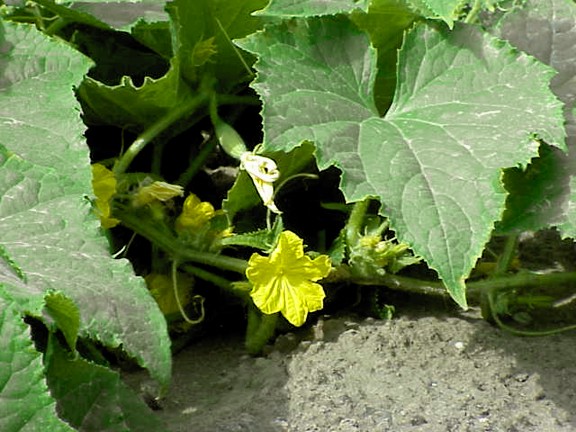
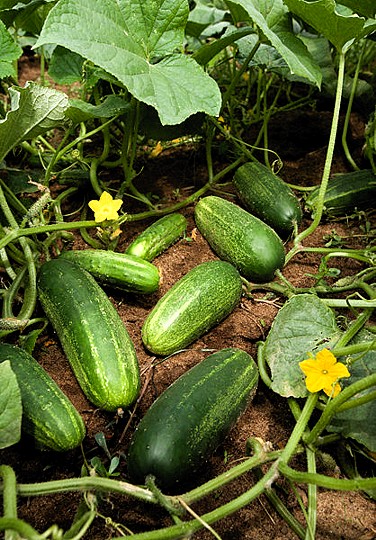
The cucumber (Cucumis sativus) is a widely cultivated plant in the gourd family Cucurbitaceae, which includes squash, and in the same genus as the muskmelon.
Botany
The cucumber is a creeping vine that roots in the ground and grows up trellises or other supporting frames, wrapping around ribbing with thin, spiraling tendrils. The plant has large leaves that form a canopy over the fruit.
The fruit is roughly cylindrical, elongated, with tapered ends, and may be as large as 60 cm long and 10 cm in diameter. Cucumbers grown to be eaten fresh (called slicers) and those intended for pickling (called picklers) are similar. Cucumbers are mainly eaten in the unripe green form. The ripe yellow form normally becomes too bitter and sour.
Having an enclosed seed and developing from a flower, cucumbers are scientifically classified as fruits. Much like tomatoes and squash, however, their sour-bitter flavor contributes to cucumbers being perceived, prepared and eaten as vegetables. It should be noted that vegetable is a purely culinary term, and as such, there is no conflict in classifying cucumber as both a fruit and a vegetable.
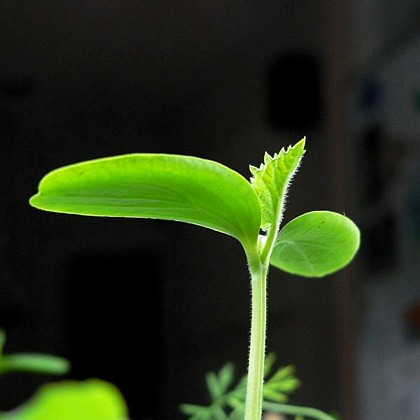
A cucumber sprout with its first leaves
Flowering and pollination
A few varieties of cucumber are parthenocarpic, the blossoms creating seedless fruit without pollination. Pollination for these varieties degrades the quality. In the US, these are usually grown in greenhouses, where bees are excluded. In Europe, they are grown outdoors in some regions, and bees are excluded from these areas. Most cucumber varieties, however, are seeded and require pollination. Thousands of hives of honey bees are annually carried to cucumber fields just before bloom for this purpose. Cucumbers may also be pollinated by bumblebees and several other bee species.
Symptoms
of inadequate pollination include fruit abortion and misshapen fruit.
Partially pollinated flowers may develop fruit which are green and develop
normally near the stem end, but pale yellow and withered at the blossom end.
Traditional varieties produce male blossoms first, then female, in about
equivalent numbers. New gynoecious hybrid cultivars produce almost all female
blossoms. However, since these varieties do not provide pollen, they must have
interplanted a pollenizer variety and the number of beehives per unit area is
increased. Insecticide applications for insect pests must be done very
carefully to avoid killing off the insect pollinators.
Taste
There appears to be variability in the human olfactory response to cucumbers, with the majority of people reporting a mild, almost watery flavor or a light melon taste, while a small but vocal minority report a highly repugnant taste, some say almost perfume like. This likely has a genetic basis analogous to the bitter taste, phenylthiocarbamide.
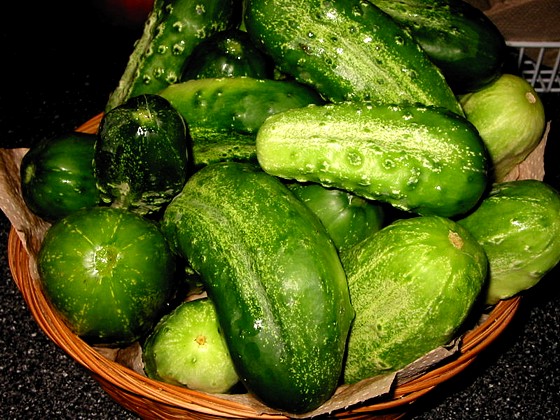
Pickling cucumbers
Cucumbers can be pickled for flavor and longer shelf life. As compared to eating cucumbers, pickling cucumbers tend to be shorter, thicker, less regularly-shaped, and have bumpy skin with tiny white- or black-dotted spines. They are never waxed. Color can vary from creamy yellow to pale or dark green. Pickling cucumbers are sometimes sold fresh as “Kirby” or “Liberty” cucumbers. The pickling process removes or degrades much of the nutrient content, especially that of vitamin C. Pickled cucumbers are soaked in vinegar or brine or a combination, often along with various spices.
Varieties
English cucumbers can grow as long as 2 feet (0.61 m). They are nearly seedless, have a delicate skin which is pleasant to eat, and are sometimes marketed as “Burpless”, because the seeds and skin of other varieties of cucumbers can give some people gas.
Japanese cucumbers (kyuri) are mild, slender, deep green, and have a bumpy, ridged skin. They can be used for slicing, salads, pickling, etc., and are available year-round.
Mediterranean cucumbers are small, smooth-skinned and mild. Like the English cucumber, Mediterranean cucumbers are nearly seedless.
Slicers grown commercially for the North American market are generally longer, smoother, more uniform in color, and have a much tougher skin. Slicers in other countries are smaller and have a thinner, more delicate skin. In North America, the term “wild cucumber” refers to manroot.
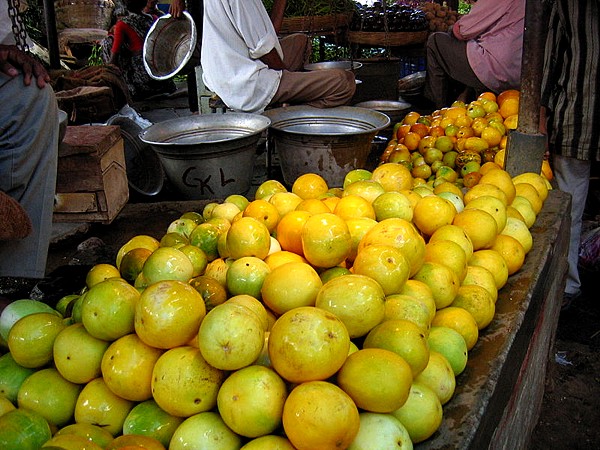
Dosakai at a market in Guntur, India.
Dosakai is a yellow cucumber available in parts of India. These vegetables are generally round in shape. It is commonly added in Sambar/Soup, Daal and also in making Dosa-Aavakaaya(Indian Pickle) and Chutney.
History of the cucumber
The cucumber has been cultivated for at least 3,000 years in Western Asia, and was probably introduced to other parts of Europe by the Romans. Records of cucumber cultivation appear in France in the 9th century, England in the 14th century, and in North America by the mid-16th century.
The cucumber is believed to be native to India, and evidence indicates that it has been cultivated in Western Asia for 3,000 years. The cucumber is also listed among the ancient Ur and the legend of Gilgamesh describes people eating cucumbers. Some sources also state that it was produced in ancient Thrace, and it is certainly part of modern cuisine in Bulgaria and Turkey, parts of which make up that ancient state. From India, it spread to Greece (where it was called “vilwos”) and Italy (where the Romans were especially fond of the crop), and later into China. The fruit is mentioned in the Bible (Numbers 11:5) as having been freely available in Egypt, even to the enslaved Israelites: We remember the fish, which we did eat in Egypt freely/the cucumbers, and the melons, and the leeks, and the onions, and the garlic. The Israelites later came to cultivate the cucumber themselves, and Isaiah 1:8 briefly mentions the method of agriculture - The Daughter of Zion is left/like a shelter in a vineyard/like a hut in a field of melons/like a city under siege. The shelter was for the person who kept the birds away, and guarded the garden from robbers.
The Roman Emperor Tiberius had the cucumber on his table daily during summer and winter. The Romans reportedly used artificial methods (similar to the greenhouse system) of growing to have it available for his table every day of the year. They would be wheeled out in carts to sit in the sun daily, then taken in to keep them warm, stored under frames or in cucumber houses glazed with oiled cloth known as “specularia”.
Cucumis
agrestis asininus
in Herbarium Blackwellianum - 1757 - by Elisabeth Blackwell
Pliny the Elder describes the Italian fruit as very small, probably like a gherkin, describing it as a wild cucumber considerably smaller than the cultivated one. Pliny also describes the preparation of a medication known as “elaterium”, though some scholars believe that he refers to Cucumis silvestris asininus, a species different from the common cucumber. Pliny also writes about several other varieties of cucumber, including the Cultivated Cucumber, and remedies from the different types (9 from the cultivated, 5 from the "anguine", and 26 from the "wild"). The Romans are reported to have used cucumbers to treat scorpion bites, bad eyesight, and to scare away mice. Wives wishing for children wore them around their waists. They were also carried by the midwives, and thrown away when the child was born.
Charlemagne had cucumbers grown in his gardens in ninth-century France. They were reportedly introduced into England in the early 1300s, lost, then reintroduced approximately 250 years later. The Spaniards (in the person of Christopher Columbus) brought cucumbers to Haiti in 1494. In 1535, Jacques Cartier, a French explorer, found “very great cucumbers” grown on the site of what is now Montreal.
Throughout the 1500s, European trappers, traders, bison hunters, and explorers bartered for the products of Native American agriculture. The tribes of the Great Plains and the Rocky Mountains learned from the Spanish how to grow European vegetables. The best farmers on the Great Plain were the Mandan Indians in what is now North and South Dakota. They obtained cucumbers and watermelons from the Spanish, and added them to the vegetables they were already growing, including several varieties of corn and beans, pumpkins, squash, and gourd plants. The Iroquois were also growing them when the first Europeans visited them.
In 1630, the Reverend Francis Higginson produced a book called, “New England’s Plantation”, in which, describing a garden on Conant’s Island in Boston Harbor known as “The Governor’s Garden”, he states: “The countrie aboundeth naturally with store of roots of great varietie and good to eat. Our turnips, parsnips, and carrots are here both bigger and sweeter than is ordinary to be found in England. Here are store of pompions, cowcumbers, and other things of that nature which I know not...”
William Wood also published in 1633’s New England Prospect (published in England) observations he made in 1629 in America: “The ground affords very good kitchin gardens, for Turneps, Parsnips, Carrots, Radishes, and Pompions, Muskmillons, Isquoter-squashes, coucumbars, Onyons, and whatever grows well in England grows as well there, many things being better and larger.”
In the later 1600s, a prejudice developed against uncooked vegetables and fruits. A number of articles in contemporary health publications state that uncooked plants brought on summer diseases and should be forbidden to children. The cucumber kept this vile reputation for an inordinate period of time: “fit only for consumption by cows”, which some believe is why it gained the name, “cowcumber”.
A copper etching made by Maddalena Bouchard between 1772 and 1793 shows this plant to have smaller, almost bean-shaped fruits, and small yellow flowers. The small form of the cucumber is figured in Herbals of the sixteenth century, but states, ‘if hung in a tube while in blossom, the Cucumber will grow to a most surprising length.’
Samuel Pepys wrote in his diary on September 22, 1663: “this day Sir W. Batten tells me that Mr. Newhouse is dead of eating cowcumbers, of which the other day I heard of another, I think.”
Fredric Hasselquist, in his travels in Asia Minor, Egypt, Cyprus and Palestine in the 1700s, came across the Egyptian or hairy cucumber, Cucumis chate. It is said by Hasselquist to be the “queen of cucumbers, refreshing, sweet, solid, and wholesome.” He also states that “they still form a great part of the food of the lower-class people in Egypt serving them for meat, drink and physic.” George E. Post, in Hastings’s “A Dictionary of the Bible”, states, “It is longer and more slender than the common cucumber, being often more than a foot long, and sometimes less than an inch thick, and pointed at both ends.”
Industry
In the United States, consumption of pickles has been slowing, while consumption of fresh cucumbers is rising. In 1999, the consumption in the US totalled 3 billion pounds of pickles with 171,000 acres (690 km²) of production across 6,821 farms and an average farm value of $361 million.
According to FAO, China produced at least 60% of the global output of cucumber and gherkin in 2005, followed at a distance by Turkey, Russia, Iran and the USA.